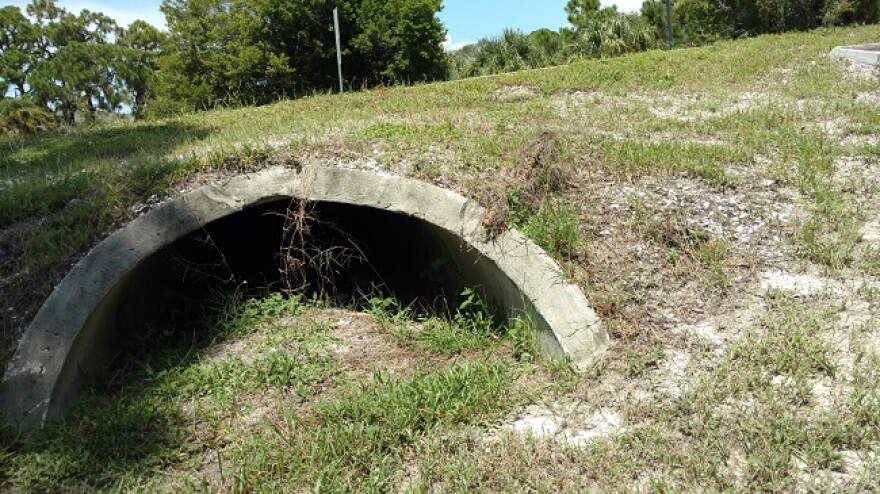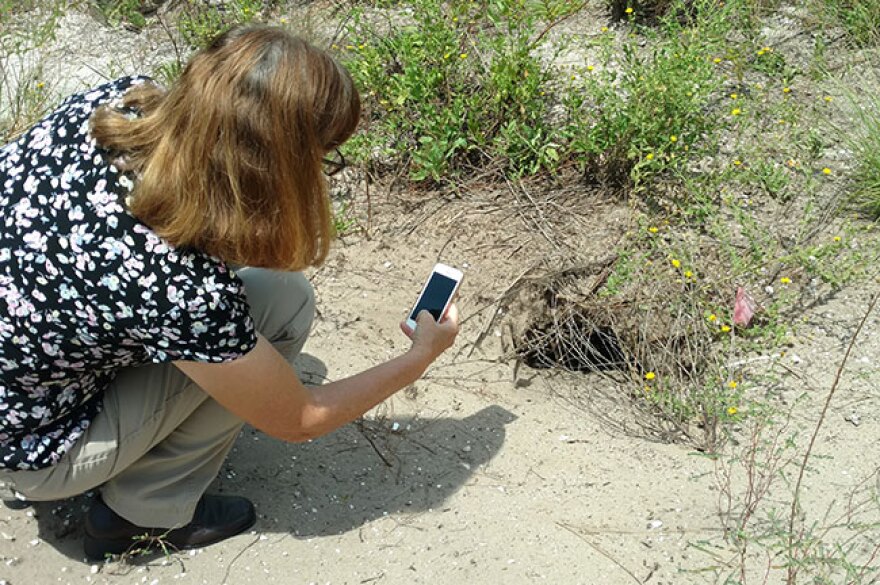Edie J. Banner is an organic chemistry instructor at the University of South Florida Sarasota-Manatee.
While most of the school’s teaching laboratories are at Mote Marine, there’s one particular lab right outside the university’s front door.
Banner said she learned in the last couple of years that the undeveloped land on campus is a conservation area populated by wildlife – with one specific animal as the key species.
“And then when I found out it was with gopher tortoises, well, they’re kind of cool and they’re protected,” Banner said.
That means both the tortoise and its burrow are guarded by Florida law. About a decade ago, there were just under 800,000 of the dry land-dwelling animals in the state, and that number was declining.
When the new campus was built, USFSM set aside two large sections of conservation land. The problem is, the main two-lane road leading into campus separates those areas. Banner said planners kept that in mind.

“Connecting these guys – you know, we don’t want them to cross that street – there are things called ecotunnels, and that’s something that’s of interest right now with a couple of my students is how are the tortoises using those tunnels, or do they even use them or are they still walking across the street?” she said.
The ecotunnels look like regular storm drains that run under the entry road, but they’re actually lined with sand and plants, making them more attractive to the tortoises.
In addition to looking at the ecotunnels, Banner and a small group of students have marked almost 50 burrows on campus. Eventually, they'd like to do a full count of the tortoises on campus.
They’ve also observed a number of the animals, ranging from juveniles to the biggest one, about 16 inches long by 16 inches wide. They’re allowed to mark them and hope to soon set up a “burrow-cam” so they can observe the tortoises’ homes up close without invading their space.
Banner and I step out of the building and walk across a parking lot to what she calls the “perfect outdoor classroom.” In the distance, we hear the Sarasota-Bradenton International Airport and the busy seven-lane highway to the east of us. To the north, there’s a hotel undergoing renovations.
But the conservation area we’re standing in is relatively quiet. It’s sandy and open with lots of scrub oaks, making it an ideal place for burrows.

She quickly points out a half-moon-shaped hole, partially obscured by plants. It’s about a foot tall and just over a foot wide, meaning it’s home to one of the area’s larger tenants.
“So this is a burrow that’s fairly active, you can see the mound of sand that’s pushed out from him digging in through, and then you can see that there’s fresh tracks there,” Banner said.
I point out the construction site and voice my concerns about the possible danger it poses.
"When they (the tortoises) start digging here," Banner says, motioning to the sandy ground, "they go down about three or four feet and then way under, so there’s nothing that’s parked there that’s impacting that.”
In addition, federal and state regulations protect gopher tortoises from construction equipment and vehicles – but the area isn’t fenced off so as not to restrict the animals’ movement. Banner then points to a long, worn-out section of grass leading south to a clearing where there's almost a dozen burrows.
“You see how it looks like a little path? That’s not our path, that’s their path, that’s the tortoise path,” she says, smiling.
Banner hopes by working in a place so familiar to the students, that they become more aware of their environment and changes to it, like the path.
And that environment includes the conservation area – a habitat for about 350 other species, including mice, skink lizards, insects and frogs, as well as a large variety of plants the animals live off of.

“I don’t want to have a whole class going out there, looking at things but when students want to do independent research and particularly field research, it’s an opportunity for them to pursue something that they are totally interested in, not necessarily what I’m doing or anyone else is doing,” she said.
The budding scientists are also building a database listing the area’s foliage and are mapping the burrows in relation to the vegetation.
“These are things that you can kind of look up and find online, but they were investigating it and that lets them think about what’s going on and understand the ecology of the whole habitat,” Banner said.
She also hopes to start an observation program, where the public can volunteer to watch for tortoises and note their activities.
You can find out more information about gopher tortoises, including an app to track them, by visiting the Florida Fish and Wildlife Conservation Commission's website.







